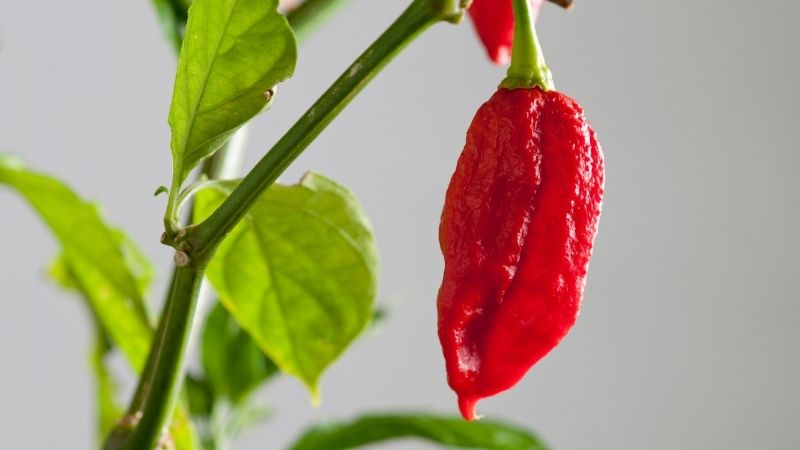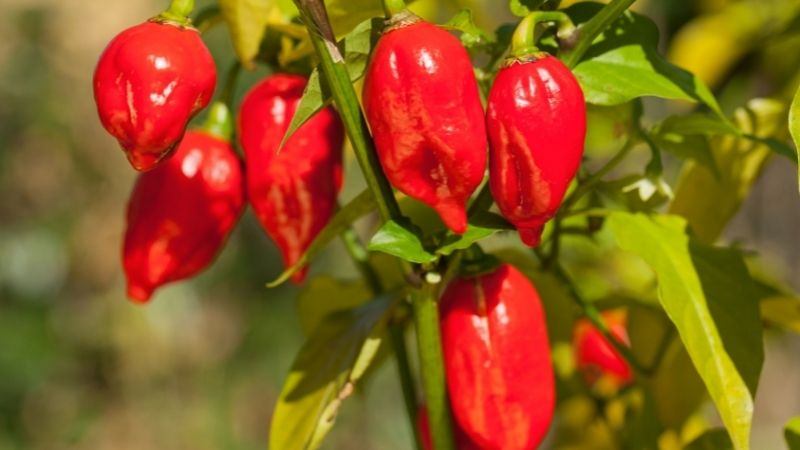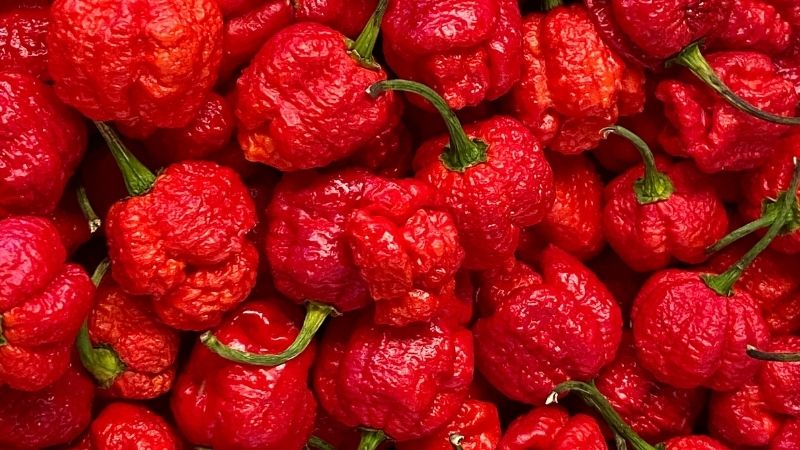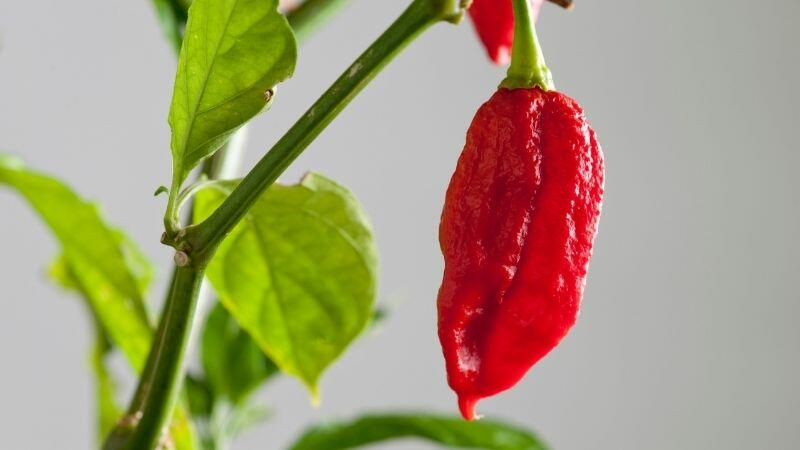With their extreme spiciness, many people wonder if ghost peppers are natural or have been genetically engineered. The answer is that yes, ghost peppers are completely natural.
These fiery chili peppers originated from crossing two wild pepper species in India. Through natural cultivation over centuries, the resulting hybrid emerged with record-breaking heat.
Although blisteringly hot, ghost peppers arose without any genetic modification. Their intense kick comes honestly from the natural combination of two already-spicy pepper parents.
In this article, we’ll explore the facts behind ghost peppers and how they developed their signature burn. You’ll learn:
- What makes up the natural genetics of ghost peppers
- Just how spicy they rank on the Scoville scale
- Where these peppers first emerged
- How to cultivate them for maximum heat
So if you’ve ever wondered whether you can handle 100% natural ghost pepper
Are Ghost Peppers Bred?

Ghost peppers aren’t genetically modified to pack extra spiciness in the product. However, this doesn’t explain how ghost peppers came to be so hot. This begs the question of whether ghost peppers were selectively bred to produce the exceptionally spicy taste.
Ghost peppers are bred. Ghost peppers have been cultivated for centuries by combining two types of pepper native to Asia. Despite the centuries of ghost pepper cultivation, this type of pepper only made its way into the western world in the early 2000s. However, ghost peppers may appear in nature.
The two peppers mixed to produce the ghost pepper share the same natural habitat. As a result, they can meet in the wild and create the hottest natural chili pepper in the world.
Growing ghost peppers isn’t easy, especially when you’re trying to get maximum heat from the chili. Ghost peppers require specific humidity and heat levels that few climates offer, making growing this type of pepper a challenge without the necessary setup and equipment.
What Exactly Are Ghost Peppers?
Before we dive into whether ghost peppers are natural, we need to understand what they are.
Ghost peppers, also known as Bhut jolokia, are a hybrid species of chili peppers native to Northeast India. They’re the result of crossing two pepper varieties:
- Capsicum chinense (habanero pepper)
- Capsicum frutescens
Both of these pepper species occur naturally in Asia. When they cross-pollinate, their offspring is the super-spicy ghost pepper.
So while the ghost pepper itself doesn’t exist independently in the wild, it is composed of two naturally occurring pepper varieties.
How Spicy Are Ghost Peppers?
Now onto the big question – just how fiery are ghost peppers?
The Scoville scale measures a chili’s pungency and places ghost peppers near the top. On this scale:
- Ghost peppers register between 800,000 to 1,001,304 Scoville heat units
- Jalapeños rank around 2,500 to 5,000 units
That means ghost peppers are about 200 to 400 times hotter than a common jalapeño! They once held the Guinness World Record for the spiciest chili pepper.
So while blisteringly hot, their extreme spiciness came about through natural cross-breeding rather than genetic tinkering.
Where Do Ghost Peppers Come From Originally?

Ghost peppers originated in Northeast India, where they’ve been cultivated for centuries. Their traditional Indian name is Bhut jolokia, which translates to “ghost chili.”
The pepper spread across India around the 16th century, likely descended from the Chinese pepper varieties also used to make Sichuan cuisine.
Ghost peppers remained relatively unknown outside of India until entering the global market in the early 2000s. Their exceptional spiciness finally gained worldwide attention.
How Are Ghost Peppers Grown?
Getting the most heat out of ghost peppers requires cultivating them in very specific conditions. Here’s a quick overview of their ideal growing needs:
- Thrive in humid climates where temperatures don’t exceed 90°F
- Take 3-5 months to fully mature
- Turn from pale green to bright red when ripe and ready to harvest
Trying to grow ghost peppers in a climate that’s too hot and arid won’t produce the highest Scoville ratings.
Are There Any Peppers Genetically Modified in the USA?
There are no genetically modified peppers in the United States available for sale. Genetically modified vegetables are highly regulated, and only certain GMO vegetables are permitted for sale. Capsicums, or peppers, as they’re also known, are not one of the permitted GMO vegetables.
There are 11 GMO vegetables approved for sale in the U.S.: Corn, potatoes, apples, alfalfa, sugar beets, cotton, canola, soybeans, summer squash, and papaya. As you can see, peppers are not one of the approved GMO products by the Food and Drugs Administration (FDA).
Therefore, food suppliers cannot legally grow GMO peppers in the United States. As a result, you don’t need to worry about tasting any genetically modified peppers by accident.
What Are Carolina Reapers Bred From?

If there’s one pepper that can rival (or even exceed) the spiciness of ghost peppers, it’s the Carolina Reaper. There’s a good reason for that, as you’ll see below. Like the ghost pepper, the Carolina Reaper has only appeared in recent years.
Carolina Reapers are bred from ghost peppers and red habanero peppers. Both ghost peppers and red habanero peppers have high Scoville ratings. As a result, their offspring, the Carolina Reaper, is one of the spiciest chili peppers. Carolina reapers have a Scoville rating of 2,200,000 SHU.
The SHU of Carolina Reapers depends on the conditions of the area where it’s cultivated. When grown correctly and fully ripe, the Carolina Reaper can reach a SHU reading of two to three million.
While the Carolina Reaper is not genetically modified, it’s not a naturally occurring capsicum either. The parent peppers of the Carolina Reaper come from opposite sides of the globe. Ghost peppers originate in India, while red habanero comes from the Amazon and has made its way up to Mexico.
The Verdict: Ghost Peppers Are All-Natural
In summary, ghost peppers came about naturally through cross-breeding – not genetic engineering.
While blisteringly hot, they originated from two pepper species that independently evolved in Asia. No GMO tinkering gave ghost peppers their signature fire.
Instead, this chili gets its extreme
So next time you take the plunge into these killer chilis, you can rest assured they came about the old-fashioned way!
Sources
- US Food and Drug Administration: GMO Crops, Animal Food and Beyond
- American Society for Horticultural Science: ‘Bhut Jolokia’—The World’s Hottest Known Chile Pepper is a Putative Naturally Occurring Interspecific Hybrid
- Bountiful Gardener: When to Harvest Your Ghost Peppers
- Pepper Geek: When To Pick Ghost Peppers (Pictures)





